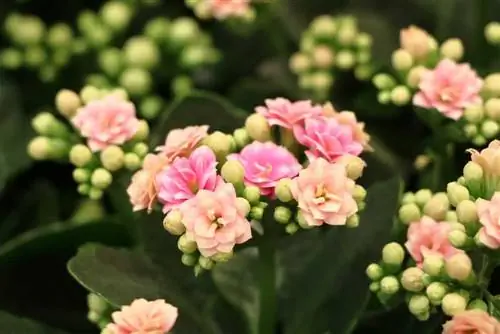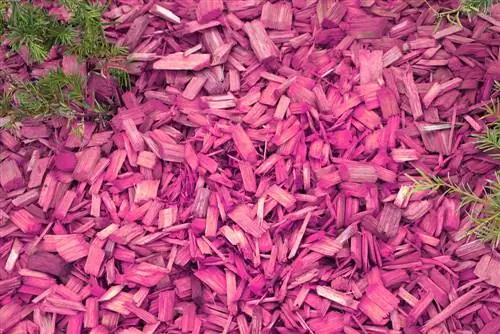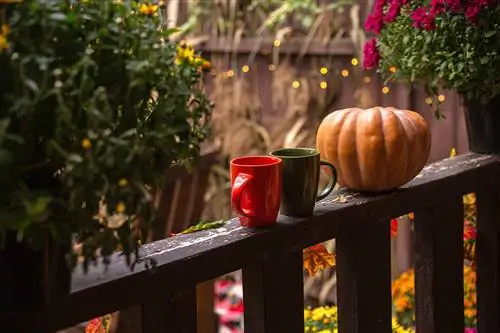- Author admin [email protected].
- Public 2023-12-17 03:39.
- Last modified 2025-06-01 06:48.
If you don't feel called upon for the higher spheres of hobby gardening, you can still enjoy green liveliness in your living spaces. Your green thumb becomes irrelevant if you specifically purchase insensitive houseplants and don't let the first, magnificent impression of capricious potted beauties in the garden center entice you to buy them. You will be spared the annoyance of curled leaves and dropped flowers with these 14 easy-care and decorative plants. Here you can get to know evergreen and flowering ornamental plants that are almost indestructible.
Evergreen ornamental foliage plants - guarantees low maintenance requirements
If houseplants forego lavish flower displays, the effort required for care is reduced to a minimum. The evergreen, decorative foliage of the following foliage plants makes it easy for us to get over the missing or inconspicuous flowers:
Bow hemp, mother-in-law's tongue (Sansevieria)
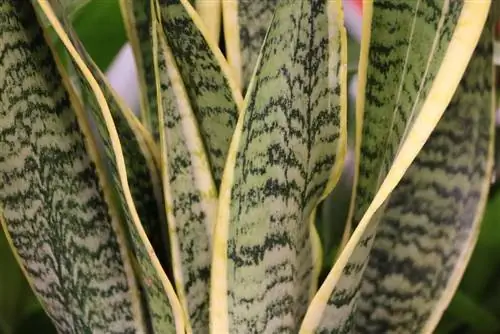
The epitome of an indestructible houseplant is a rediscovered classic. The arched hemp genus (Sansevieria) provides the inexperienced indoor gardener with a whole host of decorative species and varieties with beautifully marked, tightly upright, leathery leaves. The mother-in-law's tongue is classified as a succulent plant type because it knows how to store water reserves in its lanceolate leaves. This ability benefits home gardeners who occasionally forget to water.
- Growth height: 10 to 80 cm
- Location recommendation: sunny to shady
Money tree, penny tree (Crassula ovata)

With a money tree on the windowsill, you will attract admiring glances without being blessed with a green thumb. The richly branched shrub impresses with round, green-gray, woody shoots. The fleshy, shiny green, oval leaves with smooth edges sprout from it, from which the exotic ornamental tree owes its name. If the succulent thick-leaf plant feels in good hands, it will grow to a man's height over time. The frugal care requirements are already met with regular watering in dry conditions and monthly fertilization from March to September. Only waterlogging can bring down the robust survival artist.
- Growth height: 50 to 130 cm and higher
- Location recommendation: As bright a location as possible with lots of sunshine
Green Lily (Chlorophytum comosum)
If you are magically attracted to the spider plant with its delicate, yellow-green striped leaves in the garden center, you can take this gem with you wherever you go. The popular houseplant thrives in almost any location as long as the temperatures there do not fall below 10 degrees Celsius. The insensitive houseplant likes to display its elegantly drooping, lanceolate leaves in a hanging basket or perched on the bedroom cupboard. From spring to autumn, the substrate should be slightly moist, whereas in winter you only water it little by little. If you add a liquid fertilizer to the water every 14 days, your spider plant will be completely satisfied.
- Growth height: 30 to 40 cm; Length of leaves: up to 70 cm
- Location recommendation: bright to shady with protection from the blazing midday sun in summer
Dracaena (Dracaena)

Their palm-like silhouette with mostly colorful, lanceolate leaves and undemanding care make dragon trees indispensable companions for every indoor gardener. The diverse range of species and varieties ranges from single-stemmed giants to richly branched small-format shrubs. They all pull together in terms of cultivation. Watering in dry conditions and fertilizing from spring to autumn guarantee unadulterated plant enjoyment for many years. You will appreciate its good-natured pruning tolerance at the latest when growth takes on undesirable dimensions. Despite the habitus of a palm tree, the Dracaena is a member of the asparagus family and can be cut into shape at any time.
- Growth height: 50 to 250 cm
- Location recommendation: a bright spot by the west or east window
Tip:
Flowering potted plants are rarely suitable for greening low-light corners of rooms. Leaf ornamental plants cope better with low light intensity because they can use the smallest amounts of light for photosynthesis via the large tissue areas.
Yucca palm, palm lily (Yucca)
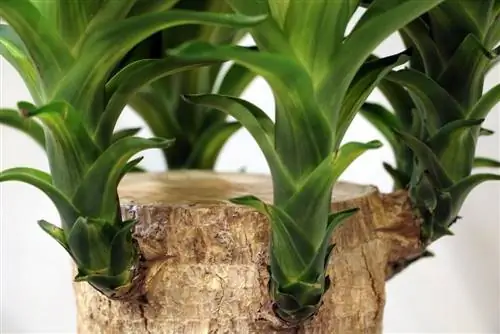
The palm lily brilliantly fulfills the desire for a houseplant that is as representative as it is easy to care for. Among the numerous species, Yucca elephantipes and Yucca aloifolia are particularly recommended for creative living space greening. One or more crowns with strong, tapered sword leaves that can reach a length of up to 100 cm form on a shapely main trunk. The yucca palm is well-disposed towards its gardener without constantly demanding care. As long as ball dryness and waterlogging are avoided, the palm-like asparagus plant gives living and working spaces an evergreen feel-good atmosphere. The desire for high humidity is fulfilled with a spray of soft water.
- Growth height: 100 to 400 cm and higher
- Location recommendation: sunny to shady, preferably with high humidity
Ivy plant (Epipremnum aureum)
The wonderful ivy comes with a whole range of advantageous attributes. The decorative climbing plant grows rapidly, adorns even room niches with little light, becomes ancient, filters pollutants from the air we breathe and is suitable for hydroponics. Upright on a climbing aid or casually in a hanging basket, the tropical foliage plant creates a relaxing jungle atmosphere in the living room, bedroom, entrance hall or office. Variegated varieties such as 'Golden Queen' or 'Variegata' provide color in the appearance. Moderate watering from March to October, a gentle spray every few days and fertilizing every 3 weeks cover the care requirements. During the winter period of dormant growth, there is less water requirement and the nutrient supply stops.
- Growth height: depending on the climbing aid up to 350 cm
- Location recommendation: bright to low light, high humidity, not below 14 degrees Celsius
Elephant foot, bottle tree, water palm (Beaucarnea recurvata and Beaucarnea stricta)
The ingenious survival strategy of succulent plants is given an extravagant shape in the elephant's foot. It is characterized by a powerful caudex as the base, from which a slender trunk rises, on which a densely bushy crown sits. Beaucarnea recurvata impresses with playfully twisted leaves, whereas the foliage of Beaucarnea stricta grows tight and straight. Since the plant stores water reserves in its basal thickening of the trunk, short-term drought does not cause any problems. When it comes to their demands, the bizarre asparagus plant is just as good-natured as the pachyderms that give it its name. The bottle tree easily forgives irregular watering as long as its root ball does not dry out. A water palm only reacts angrily to waterlogging.
- Growth height: 80 to 200 cm
- Recommended location: bright to partially shaded, preferably on the sunny balcony in summer
Tip:
Waterlogging in the root ball is a death sentence, even for insensitive houseplants. This problem is easily avoided with drainage. To do this, fill the bottom of the pot above the water drain with a 1-2 cm thick layer of expanded clay or pottery shards.
Lucky Feather (Zamioculcas zamiifolia)
If you still have a box seat available on your windowsill, the frugal lucky feather will fill this gap with evergreen beauty. Behind their elegant, graceful growth lies a modest character without any stumbling blocks in the care program. Their shrub-like habit actually consists of individual leaves composed of up to 10 pairs of leaflets. These decorative leaves arise from a fleshy rhizome that stores water. This property requires a low-maintenance care program consisting of watering in dry conditions and summer fertilizing every 4 weeks. Only the poisonous content of the arum plant limits the enjoyment of this easy-care houseplant.
- Growth height: 30 to 100 cm
- Location recommendation: bright to shady with shading in full sun, not below 16 degrees Celsius
Blooming houseplants - robust and uncomplicated
The following insensitive houseplants provide convincing evidence that uncomplicated care does not necessarily have to mean foregoing flowers. As long as a minimum light intensity of 1,000 to 1,500 lux and normal room temperatures are guaranteed at the location, these flower beauties will not cause you any headaches in the care program.
Christmas cactus (Schlumbergera)

Representing the countless species of cacti with beautiful flowers in spring, summer or winter, we would like to recommend the Christmas cactus to you. As a leaf cactus, the succulent exotic does not have sharp thorns, so the few care tasks are accompanied by painful scratches. The pretty leaves are lined up like a chain and are complemented by decorative flowers between November and February. To enjoy the winter flowers, water the plant regularly and add liquid cactus fertilizer every 4 weeks.
- Growth height: 10 to 40 cm
- Location recommendation: bright to partially shaded without direct sunlight
Wreath sling (Stephanotis floribunda)
One of the easiest-care climbing plants with a long-lasting flowering period emerges from the milkweed family. The wreath loop impresses with the dark green, shiny leaves on long tendrils that can be looped into creative shapes. White, waxy flowers appear from May to September and exude an intense scent. The uncomplicated care program is determined by abundant watering during the growth and flowering period and sparing watering in winter. If you repot the flowering beauty every spring, the nutrient supply can be eliminated. Otherwise, add liquid flower fertilizer to the water every 3 to 4 weeks in spring and summer.
- Growth height: depending on the trellis up to 400 cm
- Location recommendation: partially shaded without direct sun, ideal temperatures between 18 and 22 degrees Celsius
Clivia, strap leaf (Clivia miniata)
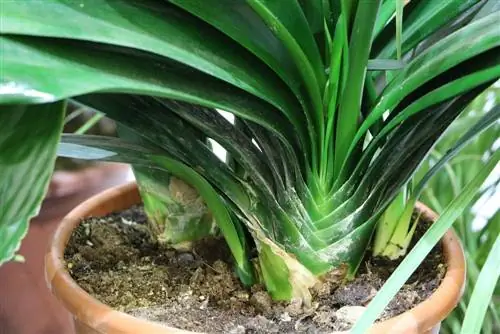
The fact that it belongs to the amaryllis family already indicates that you can look forward to beautiful flowers with a clivia. The blaze of color from February to June is accompanied by upright to slightly curved, strong leaves, which provide decorative accents even outside of the flowering period. Anyone who expects capricious care behind this floral opulence will be pleasantly surprised. The belt leaf only wants a slightly moist root ball without wet feet and 14 days of fertilization during the growth and flowering period. If one of the long-lived leaves dies, it is simply twisted out. The frugal houseplant could only react angrily to an abrupt or repeated change of location.
- Growth height: 60 to 90 cm
- Location recommendation: bright, without blazing summer sun at normal room temperatures
Pointed flower, coral berry (Ardisia)
Summer flowers and winter fruit decorations characterize this easy-care and decorative ornamental plant. The elliptical, evergreen leaves with wavy edges are a feast for the eyes, as are the white or pink flower clusters. The red berries sometimes linger on the woody shoots until the next flowering period. The pointed flower does not require time-consuming, complicated care. Rather, she kindly forgives one or two beginner mistakes. As long as the plant is supplied with water when the substrate dries, everything is fine. From March to October, add liquid fertilizer to the water every fourth watering. It is important to note that winter dormancy at around 15 degrees Celsius is required for flower induction.
- Growth height: 50 to 100 cm
- Location recommendation: sunny to partially shaded at 18 to 20 degrees Celsius
Tip:
One of the key functions of successfully caring for houseplants is avoiding hard tap water. Therefore, please use primarily collected rainwater or stale tap water.
Single leaf (Spathiphyllum)
Where elegant, white flowers sit enthroned above a flood of evergreen leaves, you can also get them as a beginner in the garden center. The leaflet will maintain its impressive aesthetics undiminished on your windowsill if only a few aspects of care are taken into account. This includes light bale moisture without waterlogging, as well as a well-drained substrate and monthly fertilization between March and September. High humidity is advantageous, but not essential. To ensure that the shiny leaves retain their dark green color, they should be watered primarily with lime-free water. Keep cunning spider mites at bay during the winter by spraying the leaves regularly.
- Growth height: 40 to 80 cm
- Location recommendation: bright to partially shaded, temperatures not below 18 degrees Celsius
Flaming Kat (Kalanchoe blossfeldiana)
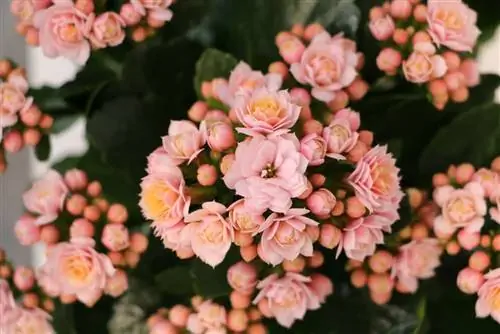
Among the succulent houseplants with a very easy care program, the Flaming Käthchen shines with its abundance of flowers. When other flowering plants retire in winter, the popular Kalanchoe species has its moment with a long-lasting flowering period that prevents winter dreariness from arising. The linchpin of the modest care program is careful watering so that the small root ball does not drown. Small varieties grow in 4-7 cm small pots and should be watered sipwise. The nutrient balance is at such a low level that fertilizing three times a year is completely sufficient.
- Growth height: 15 to 25 cm
- Location recommendation: Bright to sunny, preferably on the sunny balcony from May to September
Tip:
You can distinguish insensitive houseplants from delicate exotic plants at first glance. The leatherier the leaves and stronger shoots or trunks, the more robust the constitution. The best example is the distinctive epidermis of cacti and other succulents.
Conclusion
Has luck not been kind to you so far when it comes to keeping houseplants? Then here are 14 easy-care and decorative plants that won't be offended if you neglect to water or fertilize them. As long as the recommended site conditions are largely adhered to, these evergreen foliage plants and flowering ornamental plants will remain in all their splendor for many years. From the indestructible arched hemp to the robust money tree to the Flaming Cat, the colorful array of good-natured houseplants for creative living space greening extends.

